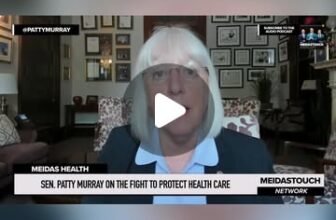Your guide to Medicaid provider taxes, and why some Senate Republicans hope to cut them
One of the most significant changes Republican lawmakers had hoped to make to Medicaid in President Donald Trump’s “One Big Beautiful Bill” is freezing or cutting state taxes on health care providers.
But as congressional Republicans scramble to push through the tax cut and spending package, the nonpartisan Senate parliamentarian ruled Thursday that many of its proposals don’t adhere to the rules governing the budget process. As is, the bill cannot be passed with a simple majority.
READ MORE: How cutting Medicaid could upend long-term care for many older Americans
Senate Republicans are trying to rework the bill, and it’s not clear whether major cuts to provider taxes will remain. Critics say they’re wasteful, calling them “money laundering” by the states and an abuse of the system.
Not all Republicans agree with the potential cuts, however. Sen. Josh Hawley, R-Mo., has raised concerns about the Senate’s slashing of Medicaid.
Experts warn that getting rid of the taxes could have an outsize effect on medical coverage and access for millions of Americans.
Provider tax revenue has “played a significant role in states’ ability to support Medicaid,” said Allison Orris, senior fellow and director of Medicaid policy at the Center on Budget and Policy Priorities.
Here’s what provider taxes are, and how changes could affect patients and health care systems in dozens of states.
What are provider taxes?
In a nutshell, they’re taxes the state levies on various health care providers, such as hospitals, nursing homes, managed care organizations and even ambulances.
It may sound counterintuitive, but providers generally like these taxes, because they contribute to a state’s total spending on Medicaid, said Alice Burns, associate director of KFF’s Program on Medicaid and the Uninsured.
Because the federal government matches state spending at a rate between 50% and 80%, with no upper limit, higher provider taxes can mean higher state spending, which results in a higher federal contribution. That money can then ultimately go back to providers in the form of increased Medicaid payment rates.
Some states have also spent provider tax revenue on funding Medicaid expansion, which allows people under higher income limits or those without dependents to access health care. Other states use the funds to help keep provider reimbursement rates high enough to ensure access for Medicaid enrollees, Orris said.
The American Hospital Association “is focused like a laser beam on ensuring the preservation of legitimate provider tax and supplemental payment programs,” wrote Rick Pollack, the organization’s president and CEO, in a June 11 blog post. He added that those taxes “serve as patches to help finance a chronically underfunded Medicaid program.”
States have been taxing health care providers since the 1980s to pay for the non-federal portion of Medicaid programs. Congress restricted the use of these taxes in 1991, establishing rules still in place today for how states implement them.
READ MORE: A closer look at who relies on Medicaid
The taxes must be “broad-based” and “uniform,” meaning they must apply equally to all providers equally within a specific class, such as hospitals or nursing homes. States also must not directly or indirectly guarantee that the money will go back to providers — a concept referred to as “holding harmless.”
However, the federal government currently exempts states from the hold harmless requirement on taxes up to 6% of revenues from treating patients. That limit is called the “safe harbor” limit, and according to KFF, 38 states have provider taxes higher than 5.5%. Georgia is the only state with provider taxes below 3.5%, and Alaska is the only state that has no provider taxes.
How would the House and Senate bills change the way they’re levied?
The House’s version of the “One Big Beautiful Bill” freezes provider taxes at their current rates and prevents states from increasing the taxes. The proposed changes in the Senate bill went a step further, reducing the safe harbor annually by 0.5% a year until the rate hit 3.5%, and only in states that have adopted Medicaid expansion.
The House bill would apply to all facilities, while the Senate’s version exempted nursing homes and intermediate care facilities.
What would the ripple effects be?
Twenty-two states would have to cut provider taxes under the original Senate bill, according to an analysis by KFF. That includes blue states like Oregon and New York, but also red states such as Oklahoma and Utah.
Senate Republicans may still try to redraft provider tax provisions, but it’s not clear yet how or what a new version would look like.
A Congressional Budget Office report on the House’s version of the bill estimated that a moratorium on provider tax increases would save about $89 billion in federal spending over 10 years. A freeze on taxes means states lose the flexibility they’ve traditionally been afforded, Orris said.
WATCH: Exploring the potential impact of Medicaid cuts in Trump’s big budget bill
“If there’s an economic downturn, if the state wants to expand coverage to a different population in the future, if the state tax base for whatever reason changes, you can no longer use provider taxes to fill gaps in the system,” she said.
Without the flexibility that provider taxes provide, and in conjunction with other cuts on the table, states might ultimately be forced to cut benefits and tighten eligibility requirements, Orris said. The CBO estimates that if the House bill were enacted, 10.9 million people would lose insurance by 2034. That influx of uninsured people would likely add strain to hospitals, experts say.
States have often used provider taxes to pay hospitals that serve higher numbers of uninsured patients, Burns said. Cutting those taxes could affect rural areas, where many hospitals operate on razor-thin margins, as well as urban areas, which may also see a high percentage of Medicaid patients, Orris said.
“If a hospital is suddenly getting paid less money for every Medicaid patient it sees — and this is particularly the case under the Senate bill — it sort of defies logic to think that that hospital is going to be OK,” she said. “Then when that hospital closes, or needs to close a maternity ward, it’s not just the Medicaid enrollees who suffer. It’s the entire community.”







